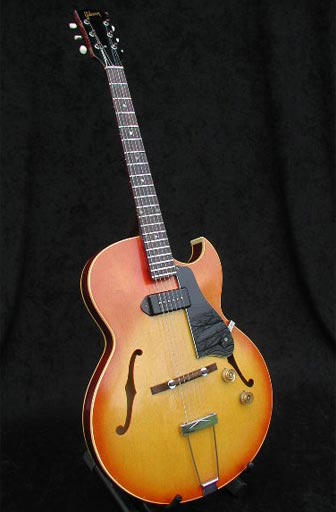Model: 1966 Gibson ES-125TC
Pickups: One single coil P90 pickup, black plastic dog-ear cover
Scale: 24 3/4"
Body: Arched maple top and back, maple sides
Neck: One piece mahogany, with rosewood fretboard. 20 frets. Pearloid dot markers
Hardware: Rosewood BR35 floating bridge, trapeze tailpiece. Individual closed-gear Kluson MH-301V tuning keys
This ES-125TC was produced at the famous Gibson Kalamazoo plant, Michigan, USA in 1966; alongside many classic guitars: ES-335s, Firebirds, SGs etc.
This example is one of 750 ES-125 TCs shipped hat year. TC stands for Thinline Cutaway (not to be confused with the non cutaway or full body depth hollow-body ES-125 models. The October 1966 recommended retail price was $265 (United States zone 1), compared to $365 for the ES-335, $305 for the SG Standard and between $199.50-$379.50 for a Firebird.
The Cherry Sunburst on the front of this guitar has faded somewhat. Compare with this 196 ES-125TC which retains a far more vibrant finish. "Cherry Sunburst" is the description of this finish used in Gibson literature of the time, although it is often called "ice-tea sunburst" in the current guitar market.
Like the vast majority of CMI-period Gibsons, this guitar has a set (glued in) mahogany neck. The back sports a rather fine deep Cherry finish, in contrast to the paler Cherry Sunburst of the front.
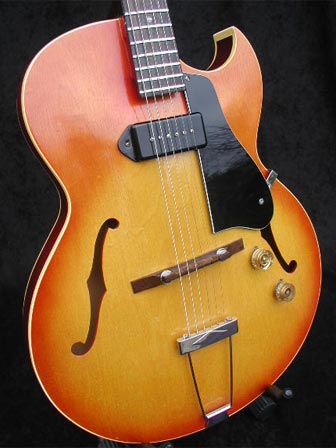
This guitar has a (somewhat faded) Cherry sunburst finish on a maple top. Cherry Sunburst is typically two-colour red and amber with none of the black or brown associated with other Gibson sunbursts. Like all Gibson thinlines it has a bound body (but unbound f-holes and neck). This is clearly a well-produced and finished guitar, but with relatively simple components. It is fitted with one P90 single coil pickup, with dog-ear mounting, a single volume and tone control, rosewood floating bridge and trapeze tailpiece.

The sides of this guitar have the same deep-cherry finish as the back, and look superb against the cream binding. Like other Gibson semi-acoustics, this guitar has no control-access cover; any electronic maintenance had to be performed by removing potentiometers through the f-holes. Fiddly, but do-able.
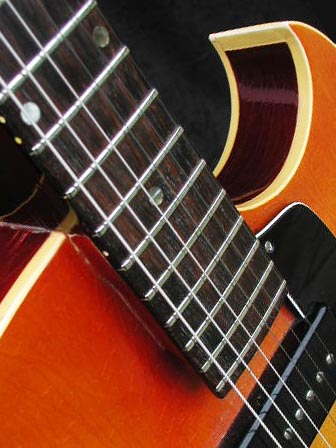
Detailed view of the rosewood fingerboard and Florentine cutaway of the ES125TC. The body is bound front and back, including along the 'point' of the Florentine edge; the neck is unbound however.
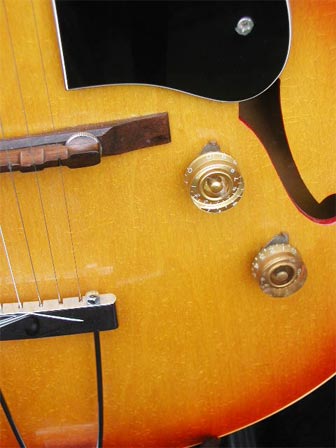
Close-up of the controls, bridge and trapeze tailpiece. As a single-pickup guitar the controls are very simple: just one volume and one tone control - these have been replaced on this instrument, and would originally have been gold bell-style knobs.

Close up of a mid 60s Gibson ES125TC headstock. Note the silk-screened Gibson logo, plain black celluloid truss rod cover. This model has none of the other headstock markings / inlays of higher end models.
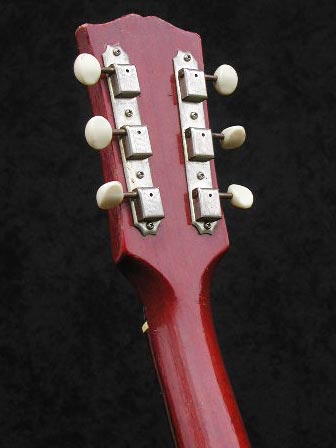
Gibson guitar necks of the 1960s were quite typically mahogany, with no volute, as is the case here. The serial number, (although not clearly visible in this image) is on the back of the headstock, right at the top. Tuning keys fitted to the ES-125TC are Kluson Deluxe; described in the 1965 Gibson parts booklet as "3 on a plate" enclosed gear, Ivoroid "oval" button - part
MH-301V
Images courtesy of justgreatguitars.com
Got an opinion on the contents of this page? Disagree with something written above? Please
comment

